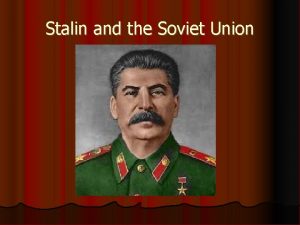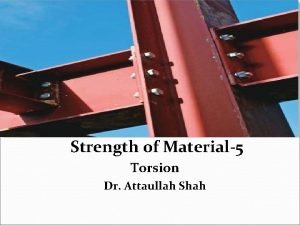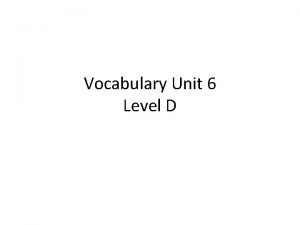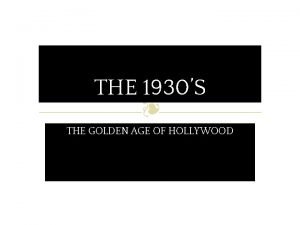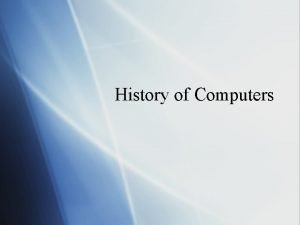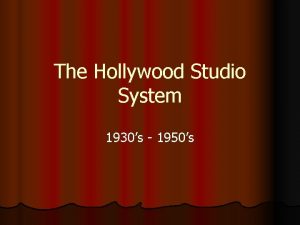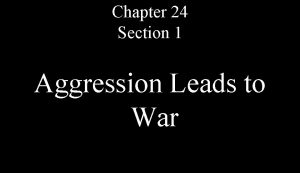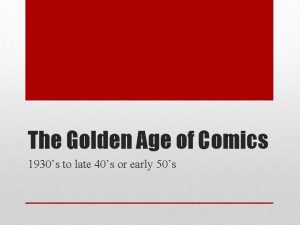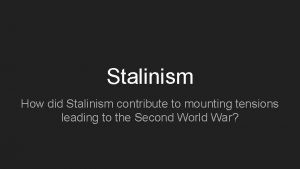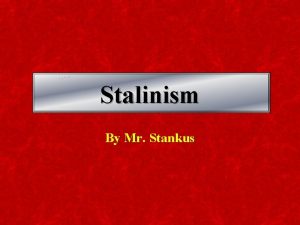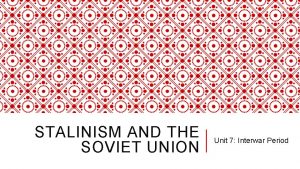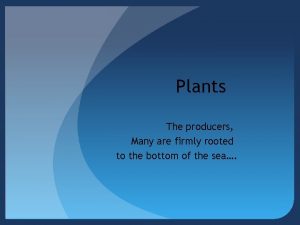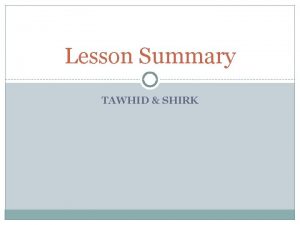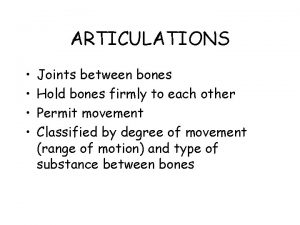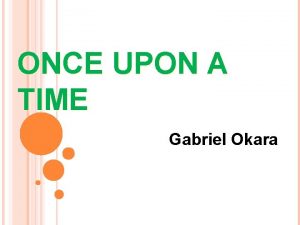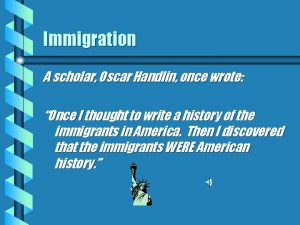Stalinism in the 1930s Once firmly in Power






















- Slides: 22

Stalinism in the 1930’s Once firmly in Power Stalin adopted Trotsky’s principle of Industrialization. “Soc. In One Country” now meant catching up to the west for communist survival. • The idea was to realize “communism” by creating greater wealth and to eliminate the NEP which was petty bourgeois, and provided for slower growth To achieve Stalin“ism” a Five Year Plan (1928) was pursued…. Summary: • Most goals not met • Human cost was high • Marx sacrificed for production • Enemies & opposition sent to Gulag

Five Year Plan (1928) We are fifty or a hundred years behind the advanced countries. We must make good this distance in ten years. Either we do it, or they will crush us. - Josef Stalin's first five-year plan helped make the USSR a leading industrial nation; albeit at the expense of millions of lives and a decline in the standard of living. Key Elements: a) Command Economy b) Collectivization c) Industry

Command Economy Free market forces eliminated (Lenin’s NEP and soft communism is wiped out) Government sets production goals for all aspects of the economy Production, distribution and consumption are controlled by the state All individual economic initiative was suppressed in the USSR

Collectivization • Definition: The unification or collectivization of many farms into one large shared farm. • Purpose: Greater equality, increased efficiency, greater, output, and mechanization. • Consequence: Kulaks: “The elimination of Kulaks as a class” Kulak’s are middle class farmers that resisted collectivization. They are ruthlessly suppressed, evicted, placed in labor camps, Siberia. (hundreds of thousands to millions die) Ukrainian Famine (1928): drop in production, resistance, slaughter of animals, forced procurements (some argue Stalin encouraged the famine in areas hostile to collectivization) http: //www. youtube. com/watch? v=Fcum. JNNX 0 qc collectivization http: //www. youtube. com/watch? v=u. QZ 9 q. WO 63 Sk&feature=related Pro collectivization

Collectivization • By 1937 90 percent of peasants were on collective farms and collectivization begins to see returns and increases to former production levels • • Statistics: 100 million peasants in 1928 and 25 million small farms (1 in 4 owned land) (75% of peasants would support collectivization 25% would resist) • By 1932 75% of farms were collective and by 1937 90% were collectivized • • • 1927 1932 grain (million tons) 69 73 cattle (million) 70 40 Pigs (million) 26 12 tractors (thousand) 25 Harvesters (thousand) 1 1937 97 63 23 200 25

Industrialization • • The creation of a 5 year plan to increase heavy industrial production (Coal, elect, steel etc) Gosplan: Central control of economy, targets for production not always keyed to demand By 1937 produce as much steel as G. Britain Lives improve; Pension’s guaranteed in constitution Free medical (more doctors per 100 people than anywhere in the world) Illiteracy falls from 50% to 19% However, the existence of slave labor and gulags, and terrible working conditions are problematic in a communist society 1927 1932 1937 • Coal (mill tons) 35 64 128 • Oil 11 21 28 • Iron 3 6 14 • Steel 4 6 17 • Tractors (thou) 25 200 • Harvesters (" ") 1 25 http: //www. youtube. com/watch? v=Nsa. Nhs 0 merk&feature=related http: //www. youtube. com/watch? v=o. XGTh. Pe. OJu 4&feature=related industrialization

Political Propaganda

Soviet Economics and Paranoia Second Five Year Plan (1933 -37) • Command economies become rigid to make up for the failure of the first five year plan • Conditions seen as harsh by many in Stalin’s government • Stalin begins to purge anyone critical of the plan, thus the revolution • All dissenters arrested by NKVD (secret police) • Show trials (outcome predetermined) Problems with the purges: • Stalin became paranoid • Purges killed off the USSR’s best thinkers and its most capable military leaders

Summation of Five Year Plans Stalin’s 3 rd Five Year Plan (1938 -1940) • Stalin sees the need (desperate in his mind) to arm Russia against another invasion. • If Soviet economy could not match production of war goods of their enemies the USSR would collapse as it had in 1917 Soviet Economy by 1941: • 5 Year Plans seldom met targets, • Farming was organized and production increased • Rapid urbanization (peasants flood cities) • Small increase in standard of living • Modernization of armed forces, though leaderless • Loss of civil liberties • Terror used as a tool of control

Purges and Labour camps • 10 -20 million dead (impossible to know true figures) – Mass movements of people – Famine caused by collectivization and its resistance – Slave labor camps (Siberia) - Gulags – Mass executions and political torture • • • Fear existed as people denounced neighbors Stalin built a “cult of personality” around himself History is distorted to support Stalin’s view

George Orwell A man is captured and is to be tortured. The torturer asks him what 2+2 equals? The man replies 4; the torturer applies electric shock to the man and then asks him again what 2+2 equals? The man again replies 4; the torturer increases the voltage and shocks the man who screams in pain. The torturer repeats the question and the man shouts, “what do you want me to say? ” The torturer says 5 which the prisoner repeats after the question is asked once more. The torturer increases the voltage to the highest setting and shocks the man who looks up at the torturer and says, “ but I told you what you wanted to hear. ” The torturer replied, “yes, but you didn’t believe it. ”………. Totalitarian Rule….

Purges Timeline • 1928: Show Trials – Confessions, non appearance, saboteurs collaborating with enemies • 1933: Ryutin Platform – a letter of criticism; one million purged • 1934: Kirov murder – 27 th Congress of “Victors” (victims) 2/3 dead • 1936: Great Purge: – Numbers unknown • • 1937: Army purged, then doctors 1938: Bukharin Show Trials http: //www. youtube. com/watch? v=E 1333 fve. Kng&feature=related

Gulag • Another aspect of the purges is the labor camps (Gulags). • Labor camps of criminals, political prisoners, victims of purges work in building projects under the worst conditions http: //www. youtube. com/watch? v=a 6 y 2 CTxbt. L 0

Cult of Personality • Changing history • Censorship • One party rule and consolidation of power • Fear and terror • Infallibility http: //www. youtube. com/watch? v=fik 2 -kg. Ogng

Soviet Foreign Policy Under Stalin: “Socialism in One Country” 1928: Kellogg-Brand Pact: Stalin never trusted the west, but he saw need to court them 1934: League of Nations: USSR joins the League to give them an international body to view global politics (expelled in 1939 for attacking Finland) 1935: Seventh Communist Congress: USSR leads via Comintern other Communist organizations in agreeing to work towards stopping the spread of Fascism 1937: USSR enters talks with England regarding Japanese expansion

USSR & Appeasement Summer 1939: France, Britain & USSR begin talks about Hitler’s expansion. However, the West only ever send low-level diplomats to deal with Stalin. Britain and France appease Hitler; Stalin loses confidence in the West Stalin sends Molotov to meet with his German counterpart Nazi-Soviet Non-Aggression Pact, 1939: • Hitler attains one-front war; Stalin gains time to prepare • Poland divided between USSR and Germany • Stalin foresaw that Germany would turn on their agreement – “Lebensraum”

Operation Barbarossa, June 1941

Learning Cell • Form a group of 5 • Each member must select a question, research (answer) that question and then teach (share) their answer with each member of the group • 10 minutes to answer your question • 5 minutes to teach (share) your answers • The cells underline the belief that History students are able to engage in self-directed learning and that they gain substantially from so doing.

Questions 1. 2. 3. 4. 5. Explain how Stalin used terror and violence to maintain a totalitarian regime in the USSR between 1928 and 1938. Briefly describe Marxism and discuss the problems that occurred in their implementation in a backward 1920 s Russia. Explain how the First World War contributed to the rise of communism in Russia. “Stalin took a backward country and transformed it into a modern state but at great cost to the Russian people. ” a) Describe the policies Stalin used to transform the USSR into a modern state. b) Justify the statement that this change came at “great cost to the Russian people. ” A a result of Lenin’s actions after November 1917 was hostility between the new communist government of Russia and the West. ” a) Describe the actions taken by Lenin’s government after the November Revolution that angered the West. b) Describe the actions taken by the Western powers in the same period that angered Lenin’s government.

Darkness at noon p. 191 How is it possible for people to commit such horrors? • • • Fear Belief that “the end (communist society) justify the means (violence) to achieve it” Stalin is a tyrant, a dictator; people “worship” and fear him Dehumanize the enemies Belief is dangerous Faith in the system Appeal to authority Skewing others ideas to maintain system of belief Self deception… awareness and denial – Abandonment of truth, results in more important truth

Ideas and discussion • 1. In pairs, To Industrialize or not Industrialize? (1927) • 2. Pick a Stalin: Macro economics how would you industrialize Russia? What problems need to be overcome? • 3. Why are the peasants enemies of the Bolsheviks? How could it have been different? • 4. Purges • Statistics: 98 – 139 Central Committee 1108 – 1916 17 th Congress 319 – 385 Regional Party Secretaries etc… First purge Left and Trotsky. Then purge Right NEP’ers. In this process elite consolidate power eliminate enemies. Eventually excesses are restrained (Yakov NKVD leader purged for “eliminating thousands of innocent party officials. ) Now younger junior officials purge the elite at the top. And so on … 5. Why Purge the party of leaders? 6. Why did Communist officials testify that they were spies, saboteurs, counter-revolutionaries? 7. Was Stalin necessary, or did he save the world? 8. Is Stalin equivalent to Hitler?

Foreign Policy • • Treaty of Brestlitovsk Treaty of Riga with Poland Rapallo Treaty Joining the League of Nations Assisting the Republicans during the Spanish Civil War Franco – Soviet Treaty Nazi Soviet Pact World War Two – Aggressor: Poland, Latvia, Lithuania, Estonia, Finland – Great Patriotic War: Defeat of Hitler’s Germany • Grand Alliance
 Stalinism
Stalinism Torsion moment
Torsion moment Hardworking, industrious, not lazy
Hardworking, industrious, not lazy Explanatory
Explanatory Dr. hawking firmly believes that
Dr. hawking firmly believes that Golden age of hollywood 1930s
Golden age of hollywood 1930s Computers in 1930s
Computers in 1930s Entertainment in 1930s
Entertainment in 1930s The hollywood studio system in the 1930s and 1940s
The hollywood studio system in the 1930s and 1940s Aggressive actions taken in the 1920s and 1930s
Aggressive actions taken in the 1920s and 1930s Comics in the 1930s
Comics in the 1930s What happens when weathering and erosion work together?
What happens when weathering and erosion work together? The real lesson 21
The real lesson 21 đại từ thay thế
đại từ thay thế Vẽ hình chiếu vuông góc của vật thể sau
Vẽ hình chiếu vuông góc của vật thể sau Công thức tiính động năng
Công thức tiính động năng Lp html
Lp html Tỉ lệ cơ thể trẻ em
Tỉ lệ cơ thể trẻ em Thế nào là mạng điện lắp đặt kiểu nổi
Thế nào là mạng điện lắp đặt kiểu nổi Lời thề hippocrates
Lời thề hippocrates Dạng đột biến một nhiễm là
Dạng đột biến một nhiễm là Vẽ hình chiếu đứng bằng cạnh của vật thể
Vẽ hình chiếu đứng bằng cạnh của vật thể Quá trình desamine hóa có thể tạo ra
Quá trình desamine hóa có thể tạo ra
